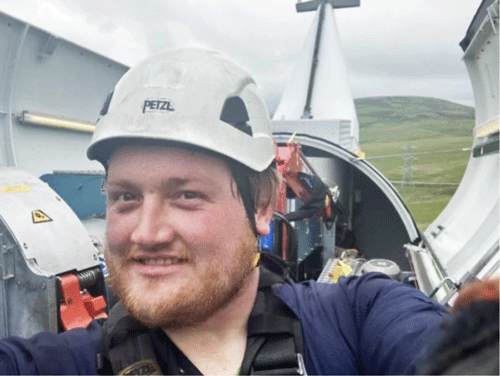George Elderfield
Prior to joining Natural Power as a full time Reliability Engineer, I worked for two years on the Knowledge Transfer Partnership (KTP) between Natural Power and University of Strathclyde. Together, we developed a new through-life management service that allows clients to monitor the health of their wind turbines and effectively plan their end-of-life strategies.
What is a KTP?
Innovate UK run the KTP scheme to help businesses in the UK innovate through collaboration with academic experts. Three parties take part in the scheme:
1. The company – Natural Power
2. The academic institution – University of Strathclyde Wind Energy and Control Centre
3. The KTP associate (me) – leads the project with support from company and academic supervision.
Being a KTP Associate
As a KTP associate I was able to transfer my academic knowledge and research skills into developing a new commercial offering. Prior to this role I was a PhD researcher and the opportunities presented by becoming a KTP associate have turned out to be vast.
Through the KTP development budget I learned new job specific and broad commercial skills. I gained GWO certification to allow me to work on operation wind turbines and fitted the load sensor system designed during the KTP. This gave me practical experience (climbing turbines!) I had not had before through academia and a renewed insight into the difficulties in operating and managing wind turbines. Installing load sensors allows me to work with real measured data and validate engineering models against these real-world measurements – something rarely available to academics working in the industry.

I have also developed my commercial skills and knowledge both through training and collaborating directly with clients to develop a new service. Through the work done during the KTP I was also able to secure my Chartered Engineering status with the IMechE.
KTP Project: Wind Turbine Through Life Management
Current operating onshore wind turbines have been designed with a lifetime of 20 years. In the next few years, many sites will begin to reach this design life. Owners will then face the decision of repowering, decommissioning, or extending their life. To safely extend the site, lifetime analysis of the wind turbine fatigue life needs to be undertaken. The methodologies used to achieve this currently use engineering models of generic wind turbines to predict the load history of the wind turbines on site.
This KTP has developed a methodology which combines load measurement of a selection of turbines on a site with a tuned and validated engineering model of the specific turbines. This reduces the uncertainty in the fatigue analysis and allows wind farm owners to monitor the health of turbines reaching the end of life more closely. Actively measuring the loads on turbines for as much of their lifetime as possible allows for a far improved picture of the conditions experienced on site. This is more beneficial than solely relying on models. This data will prove valuable for informing end of life maintenance strategies and budgeting while also providing potential secondary benefits. These could be validation of performance enhancing controller tuning to either maximise AEP or turbine life.

